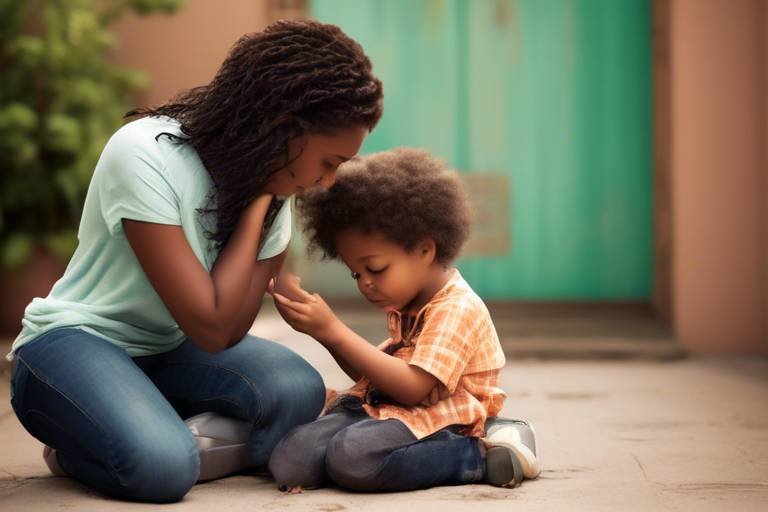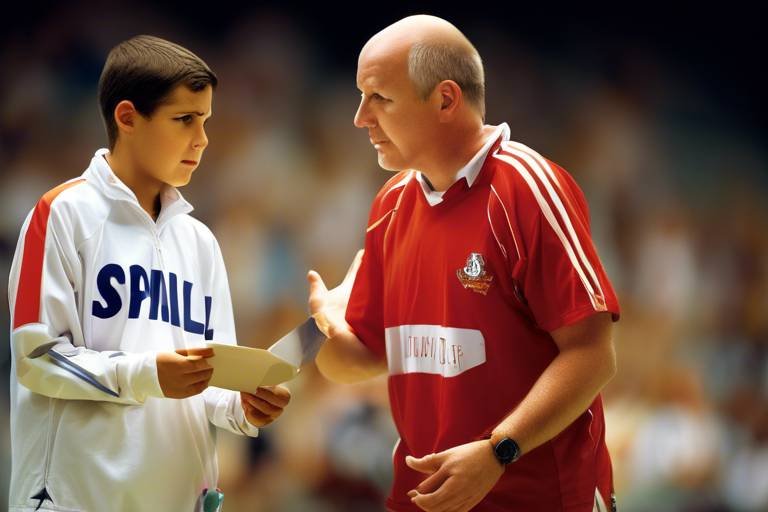Building a Relationship with Your Foster Child
Building a relationship with your foster child is one of the most rewarding yet challenging journeys you can embark on. It's like planting a seed in a garden; with the right care, attention, and patience, it can grow into something beautiful. But just as every seed is unique, so too is every child, especially those who come into foster care with their own set of experiences, emotions, and histories. The goal here is to create a nurturing environment where your foster child feels valued, safe, and loved. This process doesn’t happen overnight; it requires consistent effort and genuine commitment. Think of it as a dance where both partners must learn to move in sync, adapting to each other's rhythms and steps.
At the heart of this relationship-building process lies the understanding that foster children often come from backgrounds filled with uncertainty and trauma. They may carry emotional scars that can make it difficult for them to trust adults. Therefore, your approach must be gentle yet firm, allowing them to feel secure while also encouraging them to express themselves freely. Just like a puzzle, fitting each piece together takes time, but the end result is a complete picture of trust and affection.
One of the first steps in this journey is to establish a strong foundation based on empathy and understanding. Picture yourself in their shoes—how would you feel if you were suddenly placed in a new environment, away from everything familiar? It's crucial to recognize that your foster child may be grappling with feelings of abandonment, fear, or confusion. These feelings can manifest in various ways, from withdrawal to outbursts of anger. As a caregiver, your role is to provide a safe haven where they can express their emotions without judgment.
Moreover, you should focus on creating a nurturing atmosphere that promotes open communication. This doesn't just mean talking; it also involves listening—really listening—to what your foster child has to say. Imagine having a friend who never lets you speak; wouldn’t that feel frustrating? In the same way, children need to feel heard and understood. Encourage them to share their thoughts, feelings, and experiences, and reassure them that their voice matters. This will not only help them feel valued but also lay the groundwork for a deeper connection.
In summary, building a relationship with your foster child is about patience, empathy, and open communication. Remember, every small step you take towards understanding and connecting with them is a step in the right direction. It's a journey that requires commitment, but the rewards—a loving, trusting relationship—are absolutely worth it.
- How long does it take to build a relationship with a foster child? - The time it takes varies for each child, depending on their background and experiences. Patience is key.
- What should I do if my foster child is reluctant to communicate? - Try engaging them in activities they enjoy; sometimes, shared experiences can open up channels of communication.
- How can I ensure my foster child feels safe in my home? - Establishing consistent routines, setting clear boundaries, and being predictable in your responses can help create a sense of safety.
- What if my foster child has behavioral issues? - It's important to approach behavioral challenges with empathy and understanding. Seeking professional guidance can also be beneficial.

Understanding Foster Care Dynamics
Understanding the unique challenges and emotional complexities of foster care is crucial for building a solid foundation with your foster child. It's not just about providing a roof over their heads; it's about recognizing that they come from diverse backgrounds and have experienced varying degrees of trauma. This understanding can shape your approach, allowing for empathy and appropriate responses to their needs. Every foster child has a story, and these stories often include feelings of loss, abandonment, and uncertainty. By acknowledging this, you can begin to create a nurturing environment where they feel safe and valued.
Foster care dynamics can be likened to navigating a ship through a stormy sea. You, as the caregiver, are the captain, and your foster child is your crew member. They may be hesitant to trust the new vessel and may have their own fears about the journey ahead. This is why it’s essential to approach each interaction with patience and understanding. Be prepared for emotional waves that may crash unexpectedly, and learn to steer your ship with a steady hand, providing reassurance and stability.
Furthermore, it's important to recognize that each child will respond differently to their new environment. Some may be eager to engage and build relationships, while others may be more withdrawn or defensive. This variance in behavior can stem from their past experiences, and it’s vital to tailor your approach accordingly. For instance, a child who has faced neglect may struggle with trust, while one who has experienced instability might crave routine and predictability. Understanding these dynamics can help you respond appropriately and foster a sense of belonging.
To aid in this understanding, consider the following emotional complexities that often accompany foster care:
- Attachment Issues: Many foster children may have difficulty forming attachments due to previous disruptions in their lives.
- Behavioral Challenges: Trauma can manifest in various behaviors, from aggression to withdrawal, making it essential to approach these behaviors with compassion.
- Identity Struggles: Foster children often grapple with their identity, especially if they have been separated from their biological families.
- Fear of Rejection: The fear of being let down again can lead to defensive behaviors. Understanding this can help you navigate their emotional landscape.
By acknowledging these complexities, you can create a more empathetic environment that fosters healing and growth. Remember, every interaction is an opportunity to build trust and show your foster child that they are safe, valued, and loved. It’s about planting seeds of hope and nurturing them over time, allowing your relationship to blossom into something truly beautiful.

Establishing Trust and Safety
Creating a safe and trusting environment is not just a goal; it’s a necessity when it comes to building a meaningful relationship with your foster child. Imagine stepping into a new home where everything feels foreign and unsettling. That’s the reality for many foster children. They need to feel that they can trust you and that they are safe in your care. This trust doesn’t develop overnight; it requires consistent effort, patience, and understanding. One of the best ways to establish this trust is by being predictable and reliable. When a child knows what to expect from you, it helps them feel secure.
To foster this sense of safety, consider creating a routine. Children thrive on structure, and having a predictable daily schedule can significantly reduce anxiety. For instance, you might have set times for meals, homework, and bedtime. This not only helps them feel more at ease but also allows them to know that they are a valued part of the family. Additionally, ensure that your home environment is physically safe. This means childproofing areas where necessary and being mindful of potential hazards. A safe environment is a foundation upon which trust can be built.
Moreover, showing genuine care and concern for your foster child's emotional well-being is crucial. This can be as simple as asking them about their day or actively engaging in their interests. When they see that you genuinely care about their feelings and experiences, it builds a profound connection. For example, if they express excitement about a hobby or interest, take the time to learn about it together. This not only shows them that you value their passions but also creates shared experiences that can strengthen your bond.
Another important aspect of establishing trust is being transparent. Foster children often come from backgrounds filled with uncertainty and broken promises. By being open and honest with them, you demonstrate that you are different. If there are changes coming up or if something is bothering you, share that with them in an age-appropriate way. This transparency helps them understand that they can trust you to keep them informed and involved.
Lastly, it’s essential to recognize that trust is a two-way street. While you are working to establish trust with your foster child, encourage them to express their feelings and fears. Create an environment where they feel safe to share their thoughts without fear of judgment. This open communication can be the key to unlocking deeper connections and understanding their unique needs and experiences.
In summary, establishing trust and safety with your foster child involves creating a stable environment, being reliable, showing genuine care, maintaining transparency, and encouraging open communication. These elements work together to build a strong foundation, allowing your relationship to flourish.
- What are some signs that my foster child feels safe?
Look for signs like open communication, willingness to engage in activities, and a relaxed demeanor. If they seem comfortable sharing their thoughts and feelings, it’s a good indicator of safety. - How long does it take to build trust with a foster child?
Building trust takes time and varies from child to child. It can take weeks or even months, depending on their past experiences and individual personality. - What should I do if my foster child is struggling to trust me?
Be patient and consistent. Continue to show them that you are reliable and trustworthy. Engage in activities they enjoy and create opportunities for bonding.

Open Communication
Open communication is like the bridge that connects you and your foster child; without it, the relationship can feel distant and unsteady. Imagine trying to cross a river on a rickety old bridge—wouldn't you feel anxious? That's how your foster child might feel if they sense barriers in communication. To foster an environment where they feel comfortable sharing their thoughts and feelings, it's essential to create a space that encourages dialogue. Start by inviting them to express themselves, letting them know that every emotion they feel is valid. You might say something like, “I’m here to listen whenever you want to talk.” This simple statement can work wonders in making them feel valued and understood.
Moreover, it’s crucial to be genuinely interested in what they have to say. Ask open-ended questions that require more than just a yes or no answer. For instance, instead of asking, “Did you have a good day?” you could ask, “What was the best part of your day?” This not only encourages them to share more but also shows that you care about the details of their life. By actively engaging in conversations, you’ll begin to peel back the layers of their experiences, helping you understand them better.
Another effective technique is to incorporate regular family meetings or check-ins. These sessions can be structured yet informal, allowing everyone to share their thoughts in a safe environment. You might want to use a talking stick or any object that signifies whose turn it is to speak. This practice not only promotes fairness but also teaches your foster child the importance of listening and respecting others' opinions. You can even create a communication chart that outlines topics to discuss during these meetings, such as:
| Topic | Purpose |
|---|---|
| Feelings Check-In | To gauge emotional well-being |
| Daily Highlights | To celebrate achievements and share joys |
| Concerns | To address any issues or worries |
| Future Plans | To discuss upcoming events and activities |
Lastly, remember that communication isn’t just about words; it’s also about the non-verbal cues you convey. Your body language, facial expressions, and even your tone of voice can significantly impact how your foster child perceives your openness. A warm smile, a gentle touch on the shoulder, or maintaining eye contact can all signal to them that they are safe and supported. It’s essential to be mindful of these cues and ensure that they align with your verbal messages.
In conclusion, fostering open communication with your foster child is not a one-time effort, but rather an ongoing journey. By creating an inviting atmosphere, engaging in meaningful discussions, and being aware of your non-verbal communication, you can build a strong foundation of trust and understanding. This foundation will not only help your foster child feel secure but will also pave the way for a deeper emotional connection as they navigate their unique experiences.

Active Listening
Active listening is more than just hearing the words your foster child says; it's about fully engaging with them and demonstrating that their thoughts and feelings are valued. Imagine you're in a conversation where your mind is wandering, and you’re only half-listening. Wouldn't it feel disheartening if the person speaking to you noticed? This is why active listening is crucial in fostering a strong relationship with your child. It creates an atmosphere where they feel safe to express themselves without fear of judgment.
To practice active listening effectively, you can implement several strategies that not only show your foster child that you care but also help you understand their emotional landscape. Start by maintaining eye contact; it signals that you are present in the moment. Additionally, nodding your head or using small verbal acknowledgments like "I see" or "Go on" can encourage them to continue sharing. These small gestures can significantly enhance the communication experience.
Moreover, reflecting back what your foster child has said can be incredibly powerful. For instance, if they share a concern about school, you might say, “It sounds like you’re feeling overwhelmed with your homework.” This not only shows them that you’ve been listening but also helps them feel understood. You can also ask open-ended questions to delve deeper into their feelings. Questions like, “What was the best part of your day?” or “How did that make you feel?” can lead to more meaningful conversations.
Incorporating these active listening techniques can lead to a more profound emotional connection between you and your foster child. It’s essential to create a safe space where they feel comfortable sharing their thoughts. Remember, active listening is a skill that improves with practice, so be patient with yourself and your child as you both navigate this journey together.
- What is active listening? Active listening is the practice of fully concentrating, understanding, responding, and remembering what is being said in a conversation.
- Why is active listening important for foster children? It helps build trust and emotional connections, making them feel valued and understood.
- How can I improve my active listening skills? You can improve by maintaining eye contact, reflecting back what you hear, and asking open-ended questions.
- Can active listening help in other relationships? Absolutely! Active listening is a valuable skill that enhances communication in all types of relationships.

Non-Verbal Cues
When it comes to building a strong relationship with your foster child, non-verbal communication plays a crucial role that often goes unnoticed. Think about it: how many times have you felt understood without a single word being spoken? Non-verbal cues, such as body language, facial expressions, and even your tone of voice, can convey emotions and intentions far more powerfully than words alone. For your foster child, who may have experienced instability and uncertainty in their past, these cues can either build trust or create barriers.
Imagine walking into a room where someone is smiling at you, their arms open wide. Instantly, you feel welcomed and safe, right? Now, picture the opposite scenario: a person with crossed arms and a frown. The atmosphere changes, and you might feel anxious or unwelcome. This is the power of non-verbal communication. For foster children, who often come from backgrounds filled with trauma, the ability to read and respond to non-verbal signals can be a matter of emotional survival.
Here are some key non-verbal cues to be aware of when interacting with your foster child:
- Eye Contact: Making eye contact shows that you are engaged and interested in what they have to say. However, be mindful; too much eye contact can feel intimidating. Aim for a balance that feels comfortable.
- Facial Expressions: Your face can express a range of emotions. A warm smile can go a long way in making your foster child feel accepted and loved. Conversely, a furrowed brow might signal disapproval or concern.
- Body Language: Open body language, such as uncrossed arms and leaning slightly forward, indicates that you are approachable. In contrast, closed-off body language can make your foster child feel distant and unwelcomed.
Additionally, it’s essential to be aware of your own non-verbal signals. Children are incredibly perceptive; they can pick up on your stress or discomfort, which might make them feel uneasy. If you’re feeling overwhelmed, it’s okay to take a moment to breathe and reset your emotions before engaging with them. Remember, your emotional state can influence theirs, so strive to maintain a calm and reassuring presence.
In conclusion, mastering non-verbal cues is not just about being aware of your own body language; it’s also about tuning into your foster child's responses. Their non-verbal signals can provide invaluable insights into their feelings and needs. By fostering an environment where both verbal and non-verbal communication can thrive, you’ll be taking significant steps toward building a trusting and loving relationship.
Q: How can I improve my non-verbal communication skills with my foster child?
A: Practice being mindful of your body language, facial expressions, and tone of voice. Engage in activities where you can observe and respond to your foster child's non-verbal signals.
Q: What if my foster child is non-verbal or has difficulty expressing themselves?
A: In such cases, pay extra attention to their body language and facial expressions. Encourage them to use art or play to express their feelings, as these can be powerful non-verbal outlets.
Q: Can non-verbal cues help in resolving conflicts?
A: Absolutely! Non-verbal communication can help de-escalate tensions. For instance, maintaining a calm demeanor and using open body language can reassure your foster child during disagreements.

Building Emotional Connections
Building emotional connections with your foster child is not just about spending time together; it’s about creating moments that resonate deeply with both of you. Think of it as planting seeds in a garden—each shared experience is like watering those seeds, helping them grow into something beautiful. When you engage in activities that your foster child enjoys, you’re not only having fun but also laying down the roots of trust and affection. This connection is vital because it helps them feel valued, understood, and part of a family.
One effective way to foster these emotional bonds is through shared activities. Whether it’s cooking a meal together, playing games, or going for a walk, these moments allow for natural conversations and laughter. Imagine the joy of preparing a favorite dish—smelling the spices, chopping vegetables, and sharing stories about family traditions around the dinner table. These shared experiences create memories that your foster child will cherish, strengthening the emotional ties between you.
Additionally, don’t underestimate the power of routine. Establishing family traditions, such as movie nights or weekend outings, can create a sense of belonging and stability. These routines become something your foster child can look forward to, providing a comforting structure in their often unpredictable world. It’s like having a cozy blanket on a chilly day—these traditions wrap them in warmth and security.
Engaging in open-ended conversations is another powerful tool in building emotional connections. Ask your foster child about their dreams, fears, and interests. Show genuine curiosity about their thoughts. This doesn’t just help you understand them better; it also communicates that their feelings are valid and important. For instance, if they mention a fear of being away from home, take the time to discuss it openly. Acknowledge their feelings and share your own experiences. This two-way street of sharing can deepen your relationship significantly.
Finally, remember to celebrate their achievements, no matter how small. Recognizing their efforts fosters a sense of accomplishment and encourages them to strive for more. Whether it’s a good grade in school or mastering a new skill, make it a point to acknowledge their hard work. You might say, “I’m so proud of how hard you worked on that project!” This kind of affirmation can have a profound impact on their self-esteem and emotional well-being.
In summary, building emotional connections with your foster child involves a blend of shared experiences, open communication, and recognition of their achievements. By investing time and effort into these aspects, you’re not just nurturing a relationship; you’re creating a safe haven where your foster child can thrive emotionally. Remember, it’s a journey, and every step you take together is a step toward a brighter future.
- How long does it take to build an emotional connection with a foster child?
Building an emotional connection can vary greatly depending on the child's background and experiences. Patience is key; some children may take longer to trust, while others might bond quickly. - What activities are best for bonding with a foster child?
Engaging in shared interests, such as arts and crafts, sports, or cooking, can be very effective. The goal is to find activities that both you and your foster child enjoy. - How can I encourage my foster child to express their feelings?
Create a safe space for them to share their thoughts without fear of judgment. Ask open-ended questions and show that you value their feelings.

Encouraging Independence
Encouraging your foster child's independence is not just about giving them space; it's about empowering them to become confident individuals. As they transition into your family, they may come with a history that makes them wary of new experiences. This is where your role becomes crucial. You need to strike a balance between providing guidance and allowing them the freedom to explore their interests and make their own decisions. Think of it like teaching a bird to fly; you can’t just push them out of the nest. You have to let them flap their wings while still being there to catch them if they fall.
One effective way to foster independence is by setting clear and reasonable boundaries. Boundaries are not just rules; they are a framework that helps children feel secure in their environment. When your foster child knows what to expect, they are more likely to take risks in a safe way. For example, you can establish guidelines around homework, screen time, and chores, which can help them understand the structure while also promoting personal responsibility. Remember, boundaries should be flexible enough to adapt to their growing needs.
Additionally, promoting decision-making skills is a vital part of encouraging independence. Start small by allowing your foster child to make choices about their daily activities. For instance, you might ask them to choose between two different after-school activities or decide what to have for dinner one night a week. This not only builds their confidence but also helps them understand the consequences of their choices. You can say, “Would you like to try soccer or art class this term?” This way, they feel involved and valued in the decision-making process.
As they grow more comfortable, you can gradually introduce more complex decisions. Perhaps they can help plan a family outing or budget their allowance for the month. This empowers them to think critically and develop problem-solving skills, which are essential for their future. You might even consider creating a small chart to track their decisions and the outcomes, which can serve as a learning tool. Here’s a simple example:
| Decision | Outcome |
|---|---|
| Choose a weekend activity | Went to the park and had fun |
| Decide on a book to read | Enjoyed the story and improved reading skills |
Lastly, remember that fostering independence is not a one-time event but a continuous journey. Celebrate their successes, no matter how small, and provide constructive feedback when things don’t go as planned. This will help them learn to navigate through life’s challenges with resilience. Encourage them to share their experiences with you, creating an environment where they feel safe to express both their triumphs and setbacks. By doing so, you reinforce the idea that independence is a valuable skill that comes with practice, patience, and support.
- How can I help my foster child feel more independent?
Start by giving them small choices in their daily life and gradually increase their responsibilities. - What if my foster child resists independence?
It’s important to be patient. Encourage them gently and assure them that it’s okay to make mistakes. - Are there specific activities that promote independence?
Yes! Activities like cooking, budgeting, and planning outings can be great ways to build decision-making skills.

Setting Boundaries
Establishing clear boundaries is not just about setting rules; it’s about creating a framework that allows your foster child to feel safe and secure within your home. Think of boundaries as the walls of a house; they provide structure and protection while allowing for growth and exploration. When children know what is expected of them and understand the limits in place, they can thrive. But how do you strike that balance? It’s a dance between guidance and freedom, and it starts with open dialogue.
First and foremost, it’s essential to communicate the boundaries clearly. Use simple language and make sure your foster child understands the reasons behind each rule. For instance, if you have a rule about screen time, explain that it’s not just a random restriction but rather a way to encourage them to engage in other activities, like reading or playing outside. This approach not only helps them grasp the importance of the boundaries but also fosters a sense of ownership over their choices.
Next, consistency is key. Imagine trying to build a sandcastle on a beach where the tide is constantly changing; it would be nearly impossible! Similarly, if boundaries are enforced inconsistently, it can lead to confusion and anxiety for your foster child. Make sure that all caregivers in the household are on the same page regarding the rules and consequences. This unified front will help your foster child feel more secure and less likely to test the limits.
Another critical aspect of setting boundaries is flexibility. While it’s important to have rules, it’s equally vital to recognize that your foster child is still learning and growing. Sometimes, life happens, and unexpected situations arise. For example, if your child has had a particularly tough day, it might be worth reconsidering the consequences of a minor infraction. This doesn’t mean that boundaries are being broken; rather, it shows that you are attentive to their emotional needs and willing to adapt when necessary.
Lastly, involve your foster child in the boundary-setting process. By allowing them to participate, you empower them and give them a sense of control over their environment. You might ask questions like, “What do you think is a fair rule about chores?” or “How can we make our home a place where everyone feels respected?” This collaborative approach not only helps them understand the importance of boundaries but also encourages them to take responsibility for their actions.
In conclusion, setting boundaries with your foster child is an essential step in building a trusting and secure relationship. By communicating effectively, being consistent yet flexible, and involving them in the process, you create a nurturing environment where they can flourish. Remember, boundaries are not walls that confine; they are the guidelines that help your foster child navigate their world with confidence.
- Why are boundaries important for foster children?
Boundaries provide a sense of safety and predictability, helping foster children feel secure in their new environment. - How can I ensure my foster child understands the boundaries?
Use clear, simple language and explain the reasons behind each rule to foster understanding. - What if my foster child tests the boundaries?
Stay consistent with the rules and consequences, but also be flexible and understanding of their emotional needs. - Can I involve my foster child in setting the boundaries?
Absolutely! Involving them in the process empowers them and gives them a sense of control over their environment.

Promoting Decision-Making Skills
Empowering your foster child to make decisions is like giving them the keys to their own car; it allows them to drive their own life in the direction they choose. When children feel capable of making choices, their self-esteem grows, and they learn to trust their instincts. This journey towards independence isn't just about letting them pick what to wear or what to eat; it's about nurturing their ability to think critically and evaluate options. So, how can you effectively promote decision-making skills in your foster child? Let's dive into some practical strategies!
First off, it's essential to create a safe space for your foster child to express their thoughts and opinions. When they know that their ideas will be respected and valued, they're more likely to engage in the decision-making process. Start by asking open-ended questions that encourage them to think critically. For example, instead of saying, "Do you want pizza for dinner?" try asking, "What do you feel like eating tonight, and why?" This invites them to consider their preferences and articulate their reasoning.
Moreover, consider involving your foster child in family decisions that affect them. This could be as simple as choosing a weekend activity or as significant as discussing household rules. When they see that their opinions matter, it fosters a sense of belonging and responsibility. You can even create a
| Option | Pros | Cons |
|---|---|---|
| Going to the park | Fresh air, exercise | Weather dependent |
| Movie night at home | Cozy, affordable | Less social interaction |
| Visiting a museum | Educational, fun | Admission fees |
Another effective way to promote decision-making is to encourage problem-solving through real-life scenarios. For instance, if they encounter a conflict with a friend, guide them through the process of resolving it. Ask questions like, "What do you think you should say to your friend?" or "How would you feel if you were in their shoes?" This not only helps them articulate their feelings but also encourages empathy and critical thinking.
Finally, remember that it's okay for your foster child to make mistakes. Mistakes are invaluable teaching moments! When they face the consequences of their decisions, they learn to evaluate their choices more carefully in the future. Be there to support them, but allow them the freedom to navigate their own path. After all, every great decision-maker has faced their share of bumps along the road!
In summary, promoting decision-making skills in your foster child is a crucial part of their emotional and psychological development. By creating a supportive environment, involving them in family decisions, encouraging problem-solving, and allowing them to learn from mistakes, you're equipping them with the tools they need to thrive. Remember, every decision they make is a step towards independence, and your guidance can make all the difference!
- How can I start involving my foster child in decision-making? Begin with small decisions, like choosing dinner or weekend activities, and gradually involve them in larger family discussions.
- What if my foster child is hesitant to make choices? Encourage them by discussing the importance of their opinions and reassure them that it's okay to make mistakes.
- How can I help my foster child learn from their mistakes? Discuss the decision-making process afterwards, focusing on what they learned and how they might approach similar situations in the future.
Frequently Asked Questions
- What are the key steps to building a relationship with my foster child?
Building a relationship with your foster child involves understanding their unique experiences, establishing trust, and fostering open communication. Start by creating a safe environment where they feel valued and heard. Engage in activities together to nurture emotional connections and encourage them to express their feelings.
- How can I establish trust and safety for my foster child?
To establish trust and safety, consistently show your foster child that you care. This can be done through simple gestures like maintaining a routine, being transparent about rules, and providing emotional support. Ensure that they know your home is a safe space where they can express themselves without fear of judgment.
- What techniques can I use to encourage open communication?
Encouraging open communication can be achieved by creating a relaxed atmosphere where your foster child feels comfortable sharing their thoughts. Use active listening techniques, ask open-ended questions, and validate their feelings. Make it a habit to check in with them regularly to discuss their day or any concerns they might have.
- What is active listening and why is it important?
Active listening is the practice of fully concentrating, understanding, and responding to what your foster child is saying. It shows them that their feelings and thoughts are important to you. This skill fosters trust and helps build a deeper emotional connection, making your foster child feel valued and understood.
- How can non-verbal cues impact my relationship with my foster child?
Non-verbal cues, such as body language and facial expressions, play a crucial role in communication. They can convey warmth, empathy, and support. Being aware of your own non-verbal signals and responding to your foster child's cues can strengthen your bond and help them feel more secure in your presence.
- How do I support my foster child's independence?
Supporting your foster child's independence involves balancing guidance with the freedom to make choices. Encourage them to take on age-appropriate responsibilities and involve them in decision-making processes. This not only builds their confidence but also helps them develop essential life skills.
- What are effective strategies for setting boundaries with my foster child?
Effective strategies for setting boundaries include being clear about expectations, discussing consequences for breaking rules, and remaining consistent in enforcement. It's essential to communicate these boundaries in a way that is respectful and understanding, allowing your foster child to feel secure and respected.
- How can I promote decision-making skills in my foster child?
To promote decision-making skills, provide your foster child with opportunities to make choices in everyday situations. Start with small decisions, like what to wear or what snack to have, and gradually introduce more significant choices. Encourage them to weigh the pros and cons of their decisions to help them develop critical thinking skills.



















